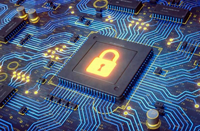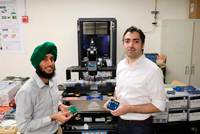Electronics News
Archive : 13 February 2018 год
 A chip, hardwired to perform public-key encryption that is said to consume only 1/400 as much power as software execution of the same protocols would, has been built by MIT. The researchers also claim it uses about 1/10 as much memory and executes 500 times faster.
A chip, hardwired to perform public-key encryption that is said to consume only 1/400 as much power as software execution of the same protocols would, has been built by MIT. The researchers also claim it uses about 1/10 as much memory and executes 500 times faster.
Most sensitive web transactions are protected by public-key cryptography and in computer networks, they’re executed by software. However, that won’t work in the IoT, an envisioned network that would connect many different sensors to online servers. MIT explains that embedded sensors that need to maximise battery life can’t afford the energy and memory space that software execution of encryption protocols would require.
The new chip uses elliptic-curve encryption which is said to be able to handle not just specific, but any elliptic curve.
“Cryptographers are coming up with curves with different properties, and they use different primes,” says Utsav Banerjee, an MIT graduate student in electrical engineering and computer science. “There is a lot of debate regarding which curve is secure and which curve to use and there are multiple governments with different standards coming up that talk about different curves. With this chip, we can support all of them and hopefully, when new curves come along in the future, we can support them as well.”
The researchers decomposed the cryptographic computation into its constituent parts to create their chip. Elliptic-curve cryptography relies on modular arithmetic. If the result of some calculation exceeds the limit, it’s divided by it and only the remainder is preserved. So one of the computations which the MIT chip devotes a special-purpose circuit to is modular multiplication.
The chip’s modular multiplier is huge because elliptic-curve cryptography deals with large numbers. MIT explains that typical modular multiplier would be able to manage numbers with 16 or maybe 32 binary digits, or bits. For larger computations, it explains, the results of discrete 16- or 32-bit multiplications would be integrated by additional logic circuits.
MIT says its chip’s modular multiplier can handle 256-bit numbers. Eliminating the extra circuitry for integrating smaller computations is said to both reduce the chip’s energy consumption and increase its speed.
In previous chips dedicated to elliptic-curve cryptography, inversions were performed by the same circuits that did the modular multiplications. The MIT chip has instead been equipped with a special-purpose inverter circuit. This is said to increase the surface area by 10%, while cutting power consumption in half.
The datagram transport layer security protocol which governs the elliptic-curve computations, formatting, transmission and handling of the encrypted data is said to be hardwired into the MIT chip. This, MIT says, reduces the amount of memory required for its execution.
The chip is said to also feature a general-purpose processor that can be used in conjunction with the dedicated circuitry to execute other elliptic-curve-based security protocols.
“They move a certain amount of functionality that used to be in software into hardware,” explains Xiaolin Lu, director of the IoT lab at Texas Instruments. “That has advantages that include power and cost. But from an industrial IoT perspective, it’s also a more user-friendly implementation. For whoever writes the software, it’s much simpler.”
Author
Bethan Grylls
Source: www.newelectronics.co.uk
 A solution for extending the battery life of wireless devices is being developed by a team at Stanford University.
A solution for extending the battery life of wireless devices is being developed by a team at Stanford University.
The idea is to attach a wake-up receiver to an electronic device, which turns on a device in response to incoming ultrasonic signals.
According to the team, by working at a smaller wavelength and switching from radio waves to ultrasound, the receiver is much smaller than similar wake-up receivers that respond to radio signals, while operating at extremely low power and with extended range.
"As technology advances, people use it for applications that you could never have thought of. The Internet and the cellphone are two great examples of that," said Angad Rekhi, a graduate student in the Arbabian lab at Stanford and one of the project researchers. "I'm excited to see how people will use wake-up receivers to enable the next generation of the IoT."
The receiver is constantly listening for a certain ultrasonic pattern, which the team claims requires only a very small amount power.
Assistant professor, Amin Arbabian, explained the challenges within the design. "Scaling down wake-up receivers in size and power consumption, while maintaining or extending range is a fundamental challenge. But this challenge is worth pursuing, because solving this problem can enable scalable networks of wake-up receivers working in our everyday environment."
The researchers used highly sensitive ultrasonic transducers from the Khuri-Yakub lab at Stanford, which they said converted analog sound input to electrical signals. This the researchers explained that this enabled them to miniaturise the wake-up receiver and reduce power consumption.
Through this, the team said they could design a system that was able to detect a wake-up signature with as little as 1 nanowatt of signal power.
This project was inspired by a previous Arbabian creation, known as the ant-sized radio. This nano chip was said to be able to send and receive signals over radio waves without a battery. The restriction here was that the chip needed to remain close to the transmitter.
By comparison, the team said, the ultrasound wake-up receiver requires a battery, but has a much greater range than the wirelessly powered devices, while still maintaining a long lifetime due to extremely low power draw.
The researchers hope that these two technologies could help to further IoT.
Author
Bethan Grylls
Source: www.newelectronics.co.uk

